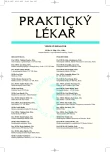-
Medical journals
- Career
Urinary prolyl-hydroxyproline dipeptide as a useful osteomarker easily determined in non-hydrolyzed urine.
Authors: P. Hušek 1,2; Z. Švagera 1; F. Všianský 1; A. Pohlídal 1; V. Šmajstrla 3
Authors‘ workplace: Ústav klinické biochemie FN, Ostrava-Poruba 1; Endokrinologický ústav, Praha Ředitel: doc. MUDr. Vojtěch Hainer, CSc. 2; Přednosta: MUDr. Antonín Pohlídal Ph. D. (do I. pol. 007) 2; Zdravotní středisko Bormed, Ostrava-Třebovice 3
Published in: Prakt. Lék. 2007; 87(11): 681-685
Category: Diagnostis
Overview
The study aimed to examine the applicability of the prolyl-4-hydroxyproline dipeptide (PHP), as a product of bone turnover, to monitor osteoporosis. Based on an earlier finding of a high correlation between PHP in non-hydrolyzed urine and hydroxyproline (HP) in hydrolyzed urine, we focused on evaluating the correlation between PHP and other traditional osteomarkers in osteopathies. Nearly 70 postmenopausal females were placed into control, osteopenic and osteoporotic groups depending on the results of DXA-denzitometry. Urinary resorption markers (NTx, DPD) were assayed together with PHP in second-void morning urine samples over 5 consecutive days, and 3 serum markers (OC, PINP and PICP) were measured in one blood sample. The influence of diet and alendronate therapy over 12 months on the osteomarkers was also followed. Analysis of variance, ROC and factor analysis and Spearman rank correlation, all served as statistical tools. To summarize, presence of PHP in the urine was not influenced by diet. ROC analysis denoted high values (≥0.9) for NTx, OC and PHP, slightly lower for DPD. These markers also denoted significantly different levels in controls and osteoporotic subjects. Highest sensitivity was found with NTx (0.886), followed by OC and PHP; NTx and DPD showed specificity close to one. The highest paired coefficients were found between OC-PHP (0.62), followed by OC-PINP, DPD-PINP and OCNTx. The highest correlation to denzitometry was shown by PHP (-0.50). Factor analysis assigned NTx-DPD into one factor and PHP-OC into a second. PHP levels dropped significantly within 3 months of treatment, whist NTx and DPD reacted slower (a significant decrease was seen after 6 months). The easy and rapid analysis of PHP in non-hydrolyzed urine offers another laboratory tool for the diagnosis of osteopathies.
Key words:
osteopathies, osteomarkers, pro-hyp dipeptide, postmenopausal women screening, diet-related effects, alendronate therapy, statistical analysis.
Labels
General practitioner for children and adolescents General practitioner for adults
Article was published inGeneral Practitioner

2007 Issue 11-
All articles in this issue
- Robot-assisted techniques in cardiology
- Fibromyalgia
- Quality of life improvement in patients with bone metastases treated by clodronate
- New options in surgical treatment
- The occurrence of heterozygous mutations in the HFE gene in chronic liver diseases
- Mesodiencephalic modulation to ease the symptoms of diabetic neuropathy – a cross-over study
- Remarks to the problems of drug-induced photosensivite reactions
- Myxoma of the left atrium
- Microangiopathic haemolytic anemia (MAHA) as a main symptom of a generalized tumour
- Acute liver failure due to disulfiram – a case study
- Squamous cell carcinoma in venous stasis ulcer
- Urinary prolyl-hydroxyproline dipeptide as a useful osteomarker easily determined in non-hydrolyzed urine.
- General Practitioner
- Journal archive
- Current issue
- Online only
- About the journal
Most read in this issue- Microangiopathic haemolytic anemia (MAHA) as a main symptom of a generalized tumour
- Acute liver failure due to disulfiram – a case study
- Fibromyalgia
- Mesodiencephalic modulation to ease the symptoms of diabetic neuropathy – a cross-over study
Login#ADS_BOTTOM_SCRIPTS#Forgotten passwordEnter the email address that you registered with. We will send you instructions on how to set a new password.
- Career

